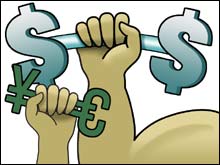Beware the falling dollarSure, it's good for Detroit, U.S. exporters and the tourism biz. But it could boost oil prices - hello, $3-a-gallon gas again - and tie the Fed's hands, leading to recession or even stagflation.(Fortune) -- Given the sorry state of U.S. manufacturing and the widening trade gap between U.S. and the rest of the world, it's understandable why there's been little hand-wringing over the falling value of the U.S. dollar. Since October, the dollar has fallen 4% against both the euro and the Japanese yen. And this week, the dollar hit the lowest it's been against the euro since March 2005. If you're an auto executive at GM (Charts) or Ford (Charts), a steelworker in Pennsylvania or a hotel manager in Florida, the falling dollar is an early Christmas present. Our products are now cheaper versus those produced abroad, aiding exports and sales at home too. Our tourist destinations are also attractive to travel-happy foreigners deciding between Florida and some other warm-weather locale.
And for the rest of us? Let's just say we've yet to see any breathless local TV news reports with mall-goers complaining how the dollar's slide is threatening to ruin Christmas - i.e. the kind of bellyaching we've heard about gas prices off and on for the past two years. Well, a little more anxiety may be in order. Fact is, a falling dollar is a stealthy drain on an economy already at risk of a slowdown. Take oil for instance. The stock market's autumn rally was directly related to the decline in energy prices and the confidence that inspired in investors. Oil fell from $77 a barrel to $56, providing relief not only to consumers but to energy-intensive industries like trucking, airlines, chemicals and manufacturing. While oil prices are less front and center in the public consciousness today than they were a few months ago, the fact is that prices are back on the rise. They're now at around $63, which represents a 7% increase in just two weeks. Part of the explanation is seasonal - oil usually eases in the fall, after the summer driving season and before the winter-heating season. But the weaker dollar has played a role in oil's climb too. How so? Like many globally traded commodities, oil is priced in dollars. Thus any weakening of the dollar versus other major currencies almost always inflates the cost of energy here at home. Consumers in London, Tokyo and Vancouver don't feel it because of their more favorable exchange rates. Tie Bernanke's hands? Another concern is how the dollar's slide could tie the hands of Federal Reserve Chairman Ben Bernanke next year. There are many signs that that the bust in the housing market will lead to a slowdown in the U.S. economy next year, if not an outright recession. U.S. economic growth is already decelerating, down to 2.2% in the third quarter from 2.6% in the second. And the latest numbers from the nation's purchasing managers showed that manufacturing activity shrank for the first time in three years last month - pressured by weakness in the housing and auto industries. If the economy does take a tumble, the Fed's normal course of action would be to lower interest rates to stimulate borrowing and spending. Problem is, a falling dollar is inflationary almost by definition, and the Fed's primary responsibility is keeping prices stable and inflation in check. Were Bernanke to lower interest rates, money would exit U.S. bonds in favor of, say, euro-dominated ones with higher yields. That would push the dollar even lower, perhaps leading to late-'70s style stagflation. Asia's assist The good news is the dollar's slide is likely almost over. There's a limit to how much the dollar can fall, argues Lord Abbett market strategist Milton Ezrati, given that the central banks of China, and, less formally, India, South Korea and Taiwan, all peg their currencies to the dollar, and thus don't want it to fall too far. (They do so to support domestic industries, for whom the U.S. is their biggest export market). These pegs support the dollar not only in Asia but against non-Asian currencies as well. "As the euro or sterling rises, for instance, Europe and British producers lose their pricing advantage not just against their American competition but also against competitors throughout this entire huge dollar area," Ezrati wrote in a recent report. "Faced with such disadvantages, they naturally will pressure their respective governments and central banks to take steps to relieve the currency strain. In the extreme, such pressure could bring recession to an already weak European economy," he wrote. "Either way, the downward pressure on the dollar would relax." |
|

